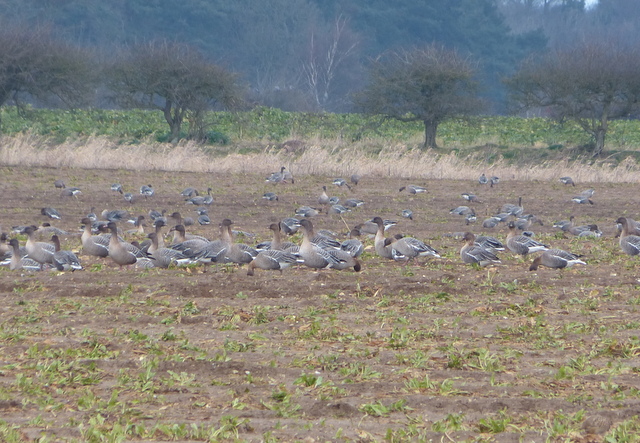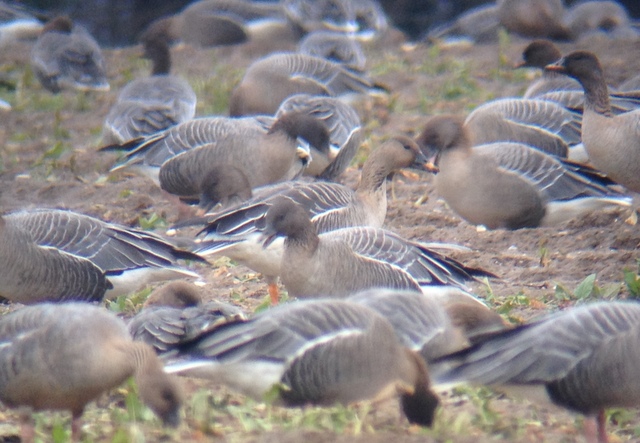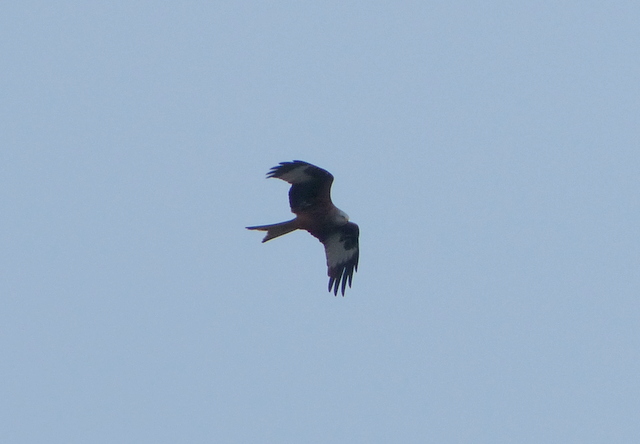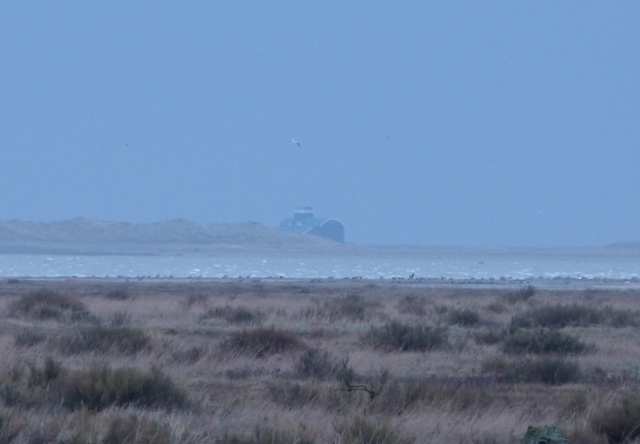The weather forecast was all over the place again today. And we were supposed to be heading out on an Owl Tour. It didn’t look particularly promising, but we pulled some Owls out of the bag and saw a few more good birds besides.
It was cold and cloudy when we met up first thing. No sign of the forecast overnight snow, and not even as icy as expected. We did a quick circuit of the marshes between Cley and Wiveton to see if a Barn Owl might still be hunting, but it was a good night and they were probably well fed and tucked up for the day.
The first stop was for Little Owls. Once again, as we approached, we could see one sat on the roof. However, like last week, and despite stopping even further away, it obviously saw us getting out of the car and flew off before we could get the scope on it. We parked up properly and scanned the surrounding fields – lots of Curlew were feeding in the stubble, and first one, then two, then four Brown Hares appeared. They chased each other around for a bit and two of them turned to face off, but only seemed inclined to a bit of shadow boxing, before running off again. A ragged flock of Brent Geese flew up from the coast and off inland. A small group of Golden Plover came up from the winter wheat with lots of Lapwing and flew overhead calling. Eventually we relocated the Little Owl, but it had tucked itself up under the edge of the roof and was now mostly hidden from view.
 Brent Geese – a flock of around 1,000 were feeding inland
Brent Geese – a flock of around 1,000 were feeding inland
As we drove on inland, an enormous flock of geese appeared in the sky ahead of us. We pulled up and lowered the windows – even from a distance we could hear the distinctive cackling chatter of Brent Geese. We watched them circle and land, and set off after them, but unfortunately they had landed in a winter wheat field out of sight from the road. We couldn’t look through them for something rarer (frustrating, as there is often a Black Brant with this group!).
More owls were proving elusive at the various barns along our meandering inland route, but geese were proving more amenable. Around the back of Holkham Park we came across a mass of Pink-footed Geese feeding in a recently harvested sugar beet field, several thousand birds strong. We parked in a convenient layby, out of sight behind a hedge, and by moving very slowly and along the hedgeline, we were able to emerge in full view of the flock without flushing it. We got a good look at their pink legs and bill bands.
 Pink-footed Geese – several thousand were feeding on a harvested field
Pink-footed Geese – several thousand were feeding on a harvested field
When faced with a big flock of geese, it is always worth scanning through carefully for something rarer. The first oddity to reveal itself turned out to be interesting but not that different – a pair of orange legs belonged to just another Pink-footed Goose, an occasional variant which can be found in that species. However, orange legs are always worth checking up on and a short while later, a pair of brighter orange legs amongst all the pink ones turned out to be a Tundra Bean Goose. A closer look revealed a second one nearby and the size difference between them suggested a pair. We watched them for some time, studying the differences from the Pinkfeet – as well as the orange legs, the orange bill band, subtly paler flanks and darker-centred wing coverts.
 A pair of orange legs amongst all the pink ones…
A pair of orange legs amongst all the pink ones…
 …became two pairs of orange legs…
…became two pairs of orange legs…
 Tundra Bean Goose – bingo! Orange-legged Beans amongst the Pinkfeet
Tundra Bean Goose – bingo! Orange-legged Beans amongst the Pinkfeet
While we were watching the geese, a Barn Owl appeared, working its way along the verge next to the road, before it flew up over a hedge and disappeared. It probably knew about the weather which was on its way and was making the most of some daytime hunting. While two of us were studying the Bean Geese, the rest of the group crossed the road and watched the Barn Owl hunting the field margins. It was hard to know which way to look!
A little further on, we stopped by some wet grazing meadows to watch a couple of Red Kites circling lazily. The meadows were alive with birds. Two pairs of Egyptian Geese chased each other around, hissing loudly. A large group of Fieldfare were feeding in the grass, along with several Mistle Thrushes. Several Grey Partridge were calling and a pair ran out – the male looked stunning in the scope, with his orange face and black kidney-shaped belly patch.
 Red Kite – two birds circled lazily overhead
Red Kite – two birds circled lazily overhead
The sun was refusing to come out and the other Little Owls were not playing ball in the cold. So we headed on to Holkham. A scan of the wetter parts of the meadows there quickly revealed a small group of Russian White-fronted Geese amongst the more numerous Greylags and a small number of lingering Pink-footed Geese. Looking more closely, there were at least 30 White-fronted Geese out there, and probably lots more – the birds kept disappearing into the thicker vegetation.
The cloud was now darkening and it was starting to rain. We stopped for lunch, in the hope that this would turn out to be the forecast wintry showers but, while wintry at times, there was no sign of the rain easing. There were lots of Wigeon and Teal along Lady Anne’s Drive, and some more Pink-footed Geese. We watched the skies to the west hoping for a break in the weather.
Finally, it seemed to brighten a little and the rain eased off. We headed round to Burnham Overy and set off along the seawall. There were several Black-tailed Godwits on the freshmarshes and several Bar-tailed Godwits in the saltwater channel, plus Ringed Plover, Redshank, Grey Plover and Dunlin. More Golden Plover were on the grazing marshes along with, confusingly, a couple more Grey Plover seeking shelter! But it was only the briefest of respite and the worst of the weather returned with a vengeance. The wind had picked up and it was howling across the saltmarsh, and the rain started lashing down. We were exposed to the very worst of it on the seawall, so we took shelter down on the lee side and headed back to the car.
Given the weather, it was clear that more owls might be a struggle. We drove back along the coast and had a quick look at Wells Harbour. There were several Little Grebes but no sign of the resident Shag today. We decided to head for Stiffkey, in the slim hope that we might be able to pick out a Hen Harrier coming in to roost in the rain from the shelter of the car.
 Blakeney Point Lifeboat House – from Stiffkey in the rain!
Blakeney Point Lifeboat House – from Stiffkey in the rain!
The rain was still lashing down, with a mixture of sleet and hail – this was all a bit too much to be called a shower now! We sat in the car and scanned the saltmarshes, but it all seemed a bit hopeless. However, gradually we started to see a few birds, despite the conditions. There are always several Little Egrets out on the marshes, whatever the weather. We also picked out our first Shelduck of the day and lots of small groups of Pintail were flying along the shoreline. A Kingfisher appeared briefly on a post, disappeared again, but then kept reappearing, hovering over one of the saltmarsh channels. The Brent Geese started to fly in from the fields to the saltmarsh to roost – probably the same birds we had seen inland earlier in the morning.
Then a ringtail Hen Harrier appeared, distantly over the saltmarsh, flying back and forth for a short while before dropping down out of sight. A couple of Marsh Harriers flew past, and a Sparrowhawk and Kestrel flashed by the car park. We thought that might be the end of it, but just as the light was fading the rain eased off again. We were about to leave when a ghostly shape appeared. A male Hen Harrier appeared in front of us and worked its way west across the saltmarsh, half way out towards the beach. Great, a perfect moment to take our leave. But just as we had got back into the car, another male Hen Harrier appeared, even closer than the last one. It circled over the near edge of the saltmarsh and drifted over campsite wood, a vision in pale grey and white, with flashing black wing tips contrasting against the sky.
With the rain now finally stopped, we felt emboldened, so we headed inland to listen for Tawny Owls. We had not long got out of the car when we could hear a Tawny Owl hooting. We walked along the road to where a second bird normally responds and positioned ourselves to wait for it to emerge from its roosting site. While we were standing there, a Barn Owl appeared behind us. It didn’t see us and came through the trees only a few feet away from us, veering away slightly only at the very last minute. A fantastic close encounter with such a stunning bird. Then the wind picked up again, the trees started to sway, the rain started to spit and the Tawny Owl fell silent, so we decided to call it a day.
That was not entirely the end of the story. We dropped some of the party off on the coast and headed inland. As we drove, the headlights picked up a shape in a tree, by the side of the road. A quick stop and gentle reverse and a Tawny Owl was perched right above the car. It sat and looked at us, and we sat and looked at it, for several minutes. It couldn’t decide whether to stay or whether to fly. Only when we finally drove on did we break the spell – it raised its wings and slipped away into the night.
















